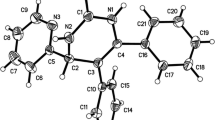Abstract
3-Amino-2-methoxycarbonylthiophene used as the main raw material, an intermediate (thiofuran siamese) 2,4-dichloro-thieno[3,2-d]pyrimidine was synthesized. The product was characterized by nuclear magnetic resonance (NMR). The first step yield was 84% (190 °C) and the second step yield was 81.4% (105 °C, m (intermediate):m (phosphorus oxychloride) = 1:6.4). The raw product was refined with a unique refining process, which can enhance the purity up to 99.5% to meet the requirement of conditions for the development and research of thiofuran siamese as a new medicine of anticarcinogen. Contrasted with the traditional technique, this process featured with cheap raw materials, possible for solvent recovery and reuse, low comprehensive cost, and suitable for production on certain scale.
Similar content being viewed by others
References
Chen C, Wu D, Guo Z Q, et al. Discovery of sodium R-(+)-4-{2-[5-(2-Fluoro-3-methoxyphenyl)-3-(2-fluoro-6-[tifluoromethyl]-benzyl)-4-methyl-2,6-dioxo-3,6-dihydro-2Hpyrimidin-1-yl]-1-phenylethylamino}butyrate(Elagolix), a potent and orally available nonpeptide antagonist of the human gonadotropin-releasing hormone receptor [J]. J Med Chem, 2008, 51(23): 7478–7485.
Brewster W K, Demeter D A, Erickson W R, et al. Thieno-pyrimidine compounds having fungicidal activity [P]. US: 0093498A1, 2007-04-26.
Boschelli D H, Wu B Q, Sosa A C B, et al. Identification of 7-phenylaminothieno-[3,2-b]pyridine-6-carbonitriles as a new class of Src kinase inhibitors[J]. J Med Chem, 2004, 47(27): 6666–6668.
Kikuchi H, Yamamoto K, Horoiwa S, et al. Exploration of a new type of antimalarial compounds based on febrifugine [J]. J Med Chem, 2006, 49(15): 4698–4706.
El-Sayed B R. Surface active properties and biological activity of novel nonionic surfactants containing pyrimidines and related nitrogen heterocyclic ring systems[J]. Grasas Y Aceites, 2008, 59(2): 110–120.
Brewster W. Thieno-pyrimidine compounds having fungicidal activity [P]. US: 0089370A1, 2006-04-27.
Krishnamurty R, Maly D J. Biochemical mechanisms of resistance to small-molecule protein kinase inhibitors[J]. Acs Chemical Biology, 2010, 5(1): 121–138.
Moore S, Jaeschke H, Kleinau G, et al. Evaluation of small-molecule modulators of the luteinizing hormone/choriogonadotropin and thyroid stimulating hormone receptors: structure-activity relationships and selective binding patterns[J]. J Med Chem, 2006, 49(13): 3888–3896.
Ivachtchenko A, Kovalenko S, Tkachenko O V, et al. Synthesis of substituted thienopyrimidine-4-ones[J]. J Comb Chem, 2004, 6(4): 573–583.
Belart E T. 4-Aminothieno[2,3-d]pyrimidine-6-carbonitrile derivatives as PDE7 inhibitors [P]. US: 7662814B2, 2010-02-16.
Wang H, Chen K, Niu G, et a1. Site-specifically biotinylated VEGF121 for near-infrared fluorescence imaging of tumor angiogenesis[J]. Mol Pharmaceu, 2002, 6(1): 285–294.
Harsha H C, Jimeno A, Molina H, et a1. Activated epidermal growth factor receptor as a novel target in pancreatic cancer therapy[J]. J Prot Res, 2008, 7(11): 4651–4658.
Munchhof M J, Beebe J S, Casavant J M, et a1. Design and SAR of thienopyrimidine and thienopyridine inhibitors of VEGFR-2 kinase activity[J]. Bioorg Med Chem Lett, 2004, 14: 21–24.
Ren Xiaolan, Wang Xin, Li Zhiyu, et al. Research progresses of epidermal growth factor receptor tyrosine kinase inhibitors[J]. Chinese Journal of New Drugs, 2005, 14(7): 821–826 (Ch).
Wood E R, Shewchukb L M, Ellisc B, et al. 6-Ethynylthieno[3,2-d]-and 6-ethynylthieno[2,3-d]pyrimidine-4-anilines as tunable covalent modifiers of ErbB kinases[J]. PNAS, 2008, 105(8): 2773–2778.
Zhang Guanglong, Ouyang Guiping, Li Wenju, et al. Research Progress of thienopyrimidine derivatives with antitumor bioactivity[J]. Fine Chemical Intermediates, 2010, 40(3): 12–17 (Ch).
Gillespie R G, Adams D R, Bebbington D, et al. Antagonists of the human adenosine A2A receptor. Part1:Discovery and synthesis of thieno[3,2-d]pyrimidine-4-methanone derivatives[J]. Bioorg Med Chem Lett, 2008, 18: 2916–2919.
Folkes A J, Ahmadi K, Alderton W K, et al. The dentification of 2-(1H-Indazol-4-yl)-6-(4-methanesulfonyl-piperazin-1-ylmethyl) -4-morpholin-4-yl-thieno[3,2-d]pyrimidine (GDC-0941)as a potent, selective, orally bioavailable inhibitor of class I PI3 kinase for the treatment of cancer[J]. J Med Chem, 2008, 51(18): 5522–5532.
Rheault T R, Caferro T R, Dickerson S H, et al. Thienopyrimidine-based dual EGFR/ErbB-2 inhibitors[J]. Bioorg Med Chem Lett, 2009, 19: 817–820.
Sutherlin D P, Sampath D, Berry M, et al. Discovery of (thienopyrimidine-2-yl) aminopyrimi dines as potent, selective, and orally available Pan-PI3-kinase and dual Pan-PI3-kinase/mTOR inhibitors for the treatment of cancer[J]. J Med Chem, 2010, 53(3): 1086–1097.
Hancox T C, Pegg N A, Nadin A J, et al. Thienopyrimidne derivatives as PI3K inhibitors [P]. US: 0021496A1, 2011-01-27.
Primeau J L, Princeton N J, Garrick L M, et al. Fused pyrimidines as angiotensin II antagonists [P]. US: 5236925, 1993-08-17.
Shuttleworth S J, Folkes A J, Chuckowree I S, et al. Pharmaceutical compounds [P]. US: 7750002, 2010-07-06.
Author information
Authors and Affiliations
Corresponding author
Additional information
Foundation item: Supported by the Innovation Fund for Technology Based Firms (10C26224212340)
Biography: DONG Liuyu, Master candidate, research direction: synthesis of medicine material medical intermediates, extract of natural active ingredients.
Rights and permissions
About this article
Cite this article
Dong, L., Gui, H., Zhou, Q. et al. A new technique for synthesis of 2,4-dichloro-thieno[3,2-d]pyrimidine. Wuhan Univ. J. Nat. Sci. 17, 177–184 (2012). https://doi.org/10.1007/s11859-012-0824-5
Received:
Published:
Issue Date:
DOI: https://doi.org/10.1007/s11859-012-0824-5




